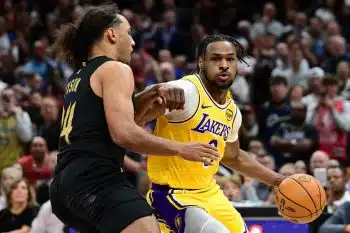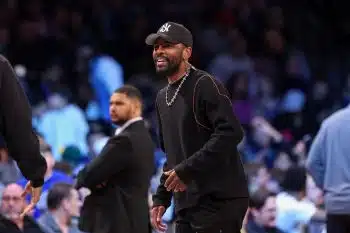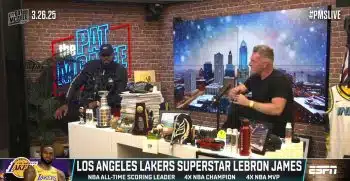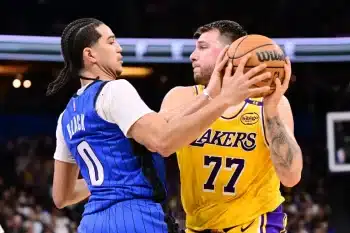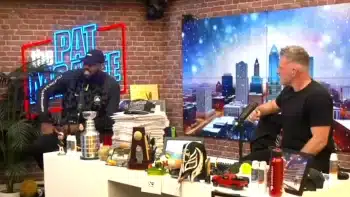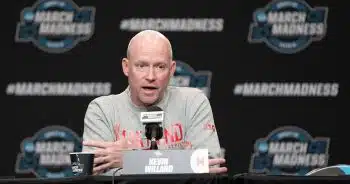NBA
NBA AM: Roberson On Entering NBA’s Defensive Elite
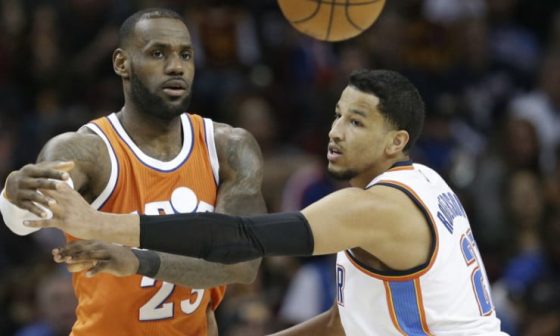
When most people think of the best wing defenders in the game today, a few typical names deservedly pop up. Kawhi Leonard. Tony Allen. Paul George. Michael Kidd-Gilchrist, if you’re just the right hint of NBA hipster.
Andre Roberson thinks he belongs on the list.
“Not to be cocky or anything, but I feel like I’m definitely one of the top defenders in the league right now,” Roberson told Basketball Insiders. “I do it a high level.”
Roberson feels the need to put a cockiness disclaimer in there, but he could be easily excused if he didn’t. Defensive numbers are a murky and imprecise science, but the ones we have available have consistently ranked Roberson right among those starrier defensive names.
The relevant figures here aren’t blocks or steals as much as they’re team metrics which reflect Roberson’s impact on the Thunder. Oklahoma City is nearly seven points per-100-possessions worse defensively when Roberson hits the bench compared to when he plays, per NBA.com, the same gap found between one of the league’s five best defenses and one of its five worst. Opponents draw fewer fouls and shoot fewer free throws while he plays, and his length on the perimeter is a big reason the Thunder’s three-point defense suffers when he sits.
These numbers can get noisy, especially with coach Billy Donovan’s substitution patterns, but ESPN’s Real Plus-Minus metric helps us contextualize by factoring for teammate and opponent context. Roberson is in the league’s top 40 by DRPM, one of just a handful of non-bigs with that distinction, and sixth among small forwards. RPM estimates he’s saved the Thunder over two points per-100-possessions, second on the team only to anchor Steven Adams. When factoring in the reality that big men are viewed more favorably by this metric, there’s a real case that Roberson has been the team’s most impactful defender.
Roberson is used to making this kind of impact. He’s been doing it since well before his NBA days.
“I always liked doing it growing up,” Roberson said. “My dad always taught me to play both sides of the game. I kind of gravitated towards the defensive end when I was getting overlooked in high school.”
That last bit might be the crux of his motivation. Plenty of pro athletes draw their fire from being passed over, and for Roberson, this started well before he hit the professional ranks. He was just a three-star high school recruit according to ESPN, listed as the 62nd ranked power forward in the country coming out of Karen Wagner High School outside of San Antonio. He watched guys around him draw rave reviews, and this was the best way he could think of to even the scales.
“I just wanted to show everybody I could still compete with those guys, and play on the same level as them,” Roberson told Basketball Insiders. “That was me going out there and having a chip on my shoulder, going out there trying to guard those guys. I guess that’s where I got it from, [and] I still hold it even to this day.”
That star-killer mindset never left, it turns out.
Roberson has become Donovan’s defensive trump card, a shutdown artist who spends long stretches making life difficult for top opposing ball-handlers. “He can guard point guards, he can guard two-guards, he can guard small forwards,” Donovan said. “He’s guarded just about everybody in the league.”
Roberson’s impressive wingspan (measured 6-foot-11 on his 6-foot-7 frame before he was drafted) helps him challenge quicker guards, and his strength honed from mostly playing the forward spots before the NBA helps him with the LeBron/George types. Quietly, he’s become one of the guys none of these stars wants to see.
“I don’t know why it don’t get noticed or people don’t pay attention to it,” said star Russell Westbrook. “But every night, he guards the other team’s best player and they don’t seem to do very well when he guards them (chuckles). He’s been doing it all season long.”
In two matchups, Roberson has held newly minted All-Star Gordon Hayward to 13-for-31 shooting. In a game against the Knicks, Roberson held Carmelo Anthony to 4-for-19. George went 7-for-20 against him recently during a really strong run of play, including just 2-for-9 from deep.
If the only Rockets games you’d seen this year were against the Thunder, you’d wonder how the hell James Harden got all this MVP buzz: Roberson has stifled him to the tune of an alarming 16-for-45 shooting in three matchups (barely 33 percent).
In a weird way, constantly being tasked with such a tough assignment makes things simpler for Roberson.
“For me, it’s kind of easier just knowing that the guy I’m guarding, most of the time the ball is gonna try to go to him,” Roberson told Basketall Insiders. “I just try to go out there and try to make it harder for him to kind of jump coverages a little bit, kind of take him out that sweet spot.”
Those star performances listed above might be isolated incidents on small samples, but season-long numbers paint a similar picture.
Roberson lands in the league’s top 10 for “field goal percentage difference allowed” among volume defenders, per SportVU – that is, the difference between a player’s normal field goal percentage on a given range of shots and his actual percentage when guarded by a particular defender, Roberson in this case. He shaves nearly five percentage points off the average shot taken when he’s the nearest defender.
In a lot of cases, these numbers are noisy and perhaps even unusable. The player who was the closest defender to a shot wasn’t necessarily the player “defending” the shooter through a possession, and the very idea that singular blame or praise can be given to one defender on a given shot doesn’t always hold for a theme as complex as NBA defense. With a bit of context, though, these conform with everything else we already know about Roberson.
For starters, his percentage isn’t heavily influenced by a big drop in opponent three-point percentage. Threes are the most variable shots in the game, and SportVU doesn’t care if you’re a foot away or six feet away – if you’re the closest defender, that shot goes on your dossier. Many of the inflated and unrealistic defensive figures we see from this data are heavily influenced by guys who just happened to be the closest defender for a lot of missed threes.
Roberson is the opposite. He’s affected opponent three-point percentage negatively (he’s affected shots from every distance range negatively), but a much lower percentage of his defended shots have been threes than many other volume wing defenders. Meanwhile, his percentages get even stingier as shooters move closer to the basket – or in other words, as we get closer to a range where these figures are reliable.
Guys see their percentages on shots within 10 feet of the hoop drop a full 7.5 percentage points when Roberson is checking them, one of the best rates in the league for wing defenders. Only a handful of non-bigs defend more shots at the rim every night, per SportVU, and of this handful, only three relative athletic freaks – Giannis Antetokounmpo, Kevin Durant and Al-Farouq Aminu – have posted a stingier percentage allowed. And remember, he’s doing it all while pretty much constantly checking the opponent’s top option, often a superstar.
Ask those close to him, and they’ll tell you Roberson has already had these skills in the bag for years. He’s had this role with Donovan since Billy came to town to replace Scott Brooks, and even held it for long periods with Brooks in town. Donovan has an interesting theoretical take on what his next step has been this year.
“Everybody offensively in the league is pretty much doing the same thing,” Donovan said. “But how you get there, and the movement, and how the floor starts to get moved, and how stuff gets disguised – [that’s] really the challenge.
“I think because of [Andre’s] experience playing in the league, his awareness in being able to read what’s getting ready to happen, what’s getting ready to take place when he may be in a vulnerable situation – he’s really, really good at that.”
The skills have always been there, but the outlines of one of the league’s smartest perimeter defenders have been forming for a while now. Roberson’s court sense has really improved, and it’s a perfect tandem with his slithery defensive nature; he gets the Thunder an extra possession or two a night by swooping in on unsuspecting big men from weird angles.
The difference between a great defender and merely a good one is often a split-second decision. Roberson’s feel for the little in-between moments that end up hopeless for most guys is part of what makes him so valuable defensively – watch him ride the middle and make a spot-on read in a spot where most guys lazily commit one way or the other and give up a wide open three.
A similar defender stylistically in Danny Green gets all the credit as the league’s preeminent transition stopper, but Roberson is nipping at his heels.
The effect on the team scheme has been the most noticeable result. Roberson has worked diligently with assistant coach Darko Rajakovic on the mental side of his game – watching film, learning opposing play calls and honing his three years of experience into a weapon.
“He’s already an amazing one-on-one [defender] – he was when he first came into the league,” Adams said of Roberson. “His steps are now really just helping everyone else on defense. He’s able to understand and read the plays, and understand, like, some plays that are just smoke screen. It helps me out a lot on pick-and-rolls.”
It’s easy to see what he means. See if you can catch the smart ways Roberson (#21 in white, top of the screen) influences this Utah Jazz possession:
First, he comes across to show Rudy Gobert a body as Gobert rolls away from the Thunder’s trap on ball-handler George Hill:
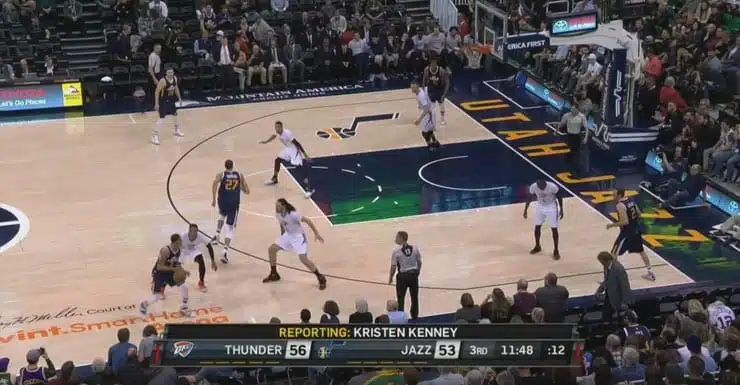
Just as quickly, though, Roberson spots the real action: Gobert is setting up to screen Roberson himself, allowing Roberson’s man, Hayward, to pop up and catch the ball on the curl:
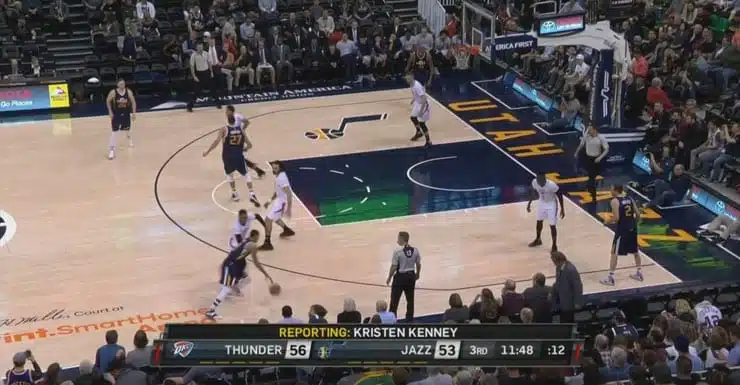
Roberson reads the Gobert pick, and beats Hayward around the corner. Hayward smartly looks to reverse the screen with Gobert, but here’s Roberson’s slithery quality again – he stays attached to Hayward’s hip through the smallest of gaps.
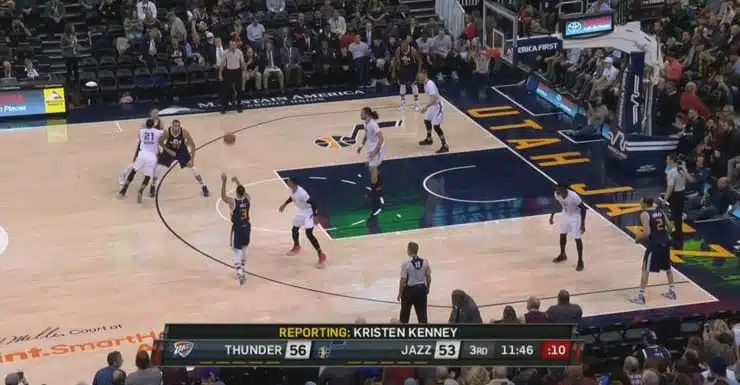
By the time Hayward has jumped for Hill’s pass and landed, Roberson is right back in his grill:
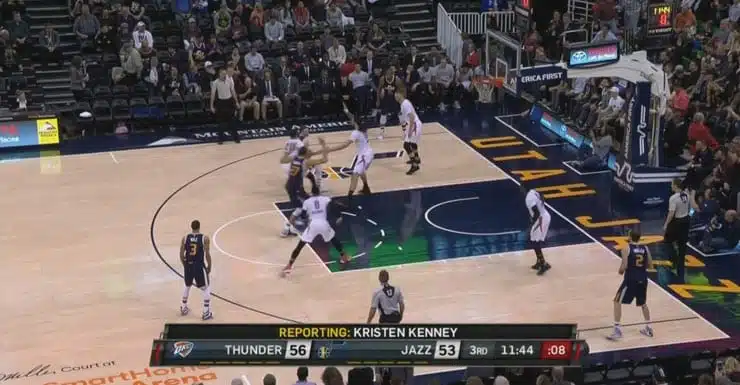
Adams can rotate back to Gobert to prevent the lob, the Thunder’s help defenders can stay home on three-point shooters, and Hayward is stuck looking for a bailout.
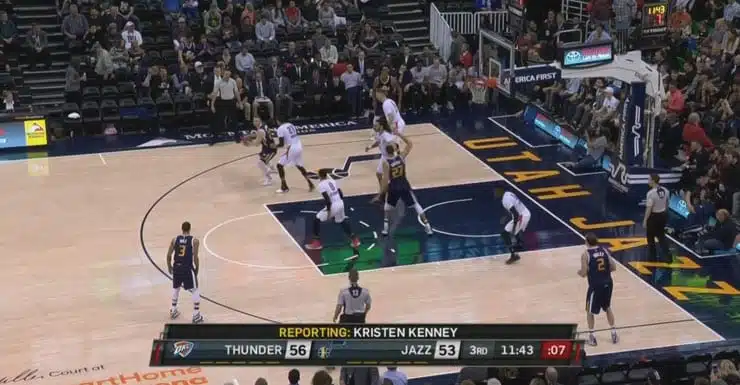
“If he didn’t do that, the dude would be going downhill against me and that’d be tragic,” Adams said in his unique style. “Exactly what we don’t want.”
All over the court, Roberson just makes stuff easier for guys. A huge percentage of his steals seem to come in areas that lead to fast breaks – part of the Thunder’s life blood offensively. Oklahoma City picks up over two extra points off turnovers for every 36 minutes he spends on the court compared to off, and they add nearly four fast break points in the same time span.
His teammates rave about his team-first attitude, and his coach goes out of his way to note the finer details of his game which have improved. Roberson just keeps doing what he’s always been doing.
“I go out there, just try to give it all my energy and effort to the defensive end,” Roberson told Basketball Insiders. “The guys follow suit, they feed off the energy and it helps them.
“The same way it works with the crowd, you feed off the crowd. I try to be the crowd for my team.”
